








Sheaffer
Autograph and Signature Pens
by Jim
Mamoulides, March 23, 2003
Thanks to
Sam Fiorella, Rob Astyk, and Deb Kinney

"No one on your gift list has anything like this," the 1950 advertisement titled Sheaffer's with Personal Signature. Though many pen manufacturers made pens with places for engraving, Sheaffer's hook was that your Sheaffer pen would carry your own personal signature, "deeply hand engraved" just as if the pen had been signed by your own hand.
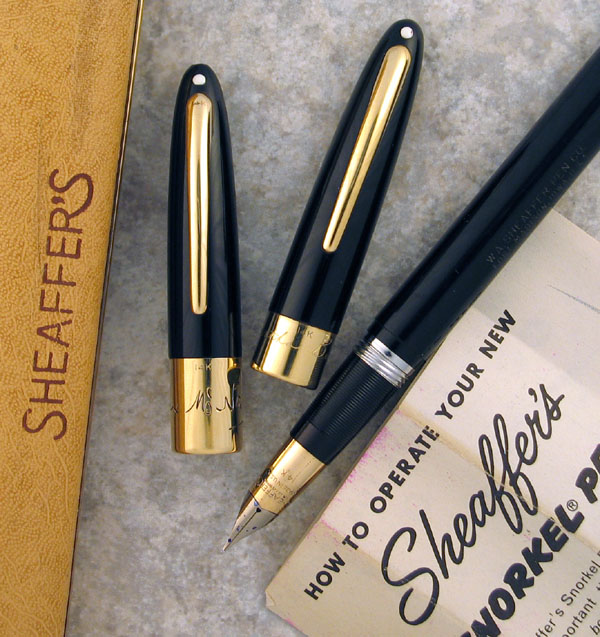
Sheaffer Snorkel Autograph Cap (Left) And Signature Pen (Right)
c1952-1959
Note Difference In Width Of Cap Band
Hand engraved pens are nothing new, and certainly weren't a novelty by 1950. Places to engrave names or initials of owners or loved ones to make the pen a keepsake or award have been set aside since pens were first made. Many early pens were hand engraved not only with names or initials, but also with elaborate decorations such as flowers and vines. Fine pens have always been close cousins of the jewelry trade, so decorating and personalizing them would come with the territory. Sheaffer's own start was in the back of a jewelry store.
How Sheaffer created exact replicas of the owner's own signature on these pens has been one of the puzzles of the pen collecting community. How did they get there? This mystery parallels the introduction and marketing of a special type of pen by Sheaffer - the Autograph.
A Solid Gold Band For Your Autograph
Jeweler engraved pens, including complete caps and barrels, were not uncommon in the early days of eyedropper pens. Some pen manufacturers offered their own hand engraved examples as part of their lines. As pens became more of a mass produced item, pen makers created space specific for personalization, often as wide bands on the cap.
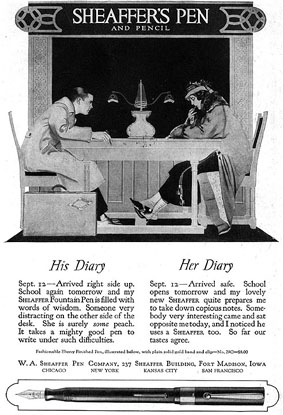
Sheaffer Ebony Finished 29C
With Solid Gold Band And Clip Advertisement 1920
Sheaffer pens with a wide solid 14 karat gold cap band can be found in advertisements dating to as early as 1917. The copy on early Sheaffer advertisements encourage the purchaser to have the pen engraved "by any competent jeweler." Such pens sold in 1917 for the handsome price of US $8.00. In 1919, the black hard rubber flat-top "Clip Cap" 49C with a wide solid gold band sold for US $8.50, a US $2.50 premium over the pen with a rolled gold band. Solid gold has always been a sign of luxury, and given Sheaffer's jeweler's roots, such pens would be in the line-up throughout the 1920s. It's not until 1931 that Sheaffer began to use the word Autograph with these pens, but the early flat-top pens with the wide solid gold bands are the genesis of the type.

Sheaffer Autograph Balance
Advertisement 1931
After the revolutionary Balance pen was introduced in 1929, Sheaffer continuously developed and expanded the line, offering more colors and modifying the shape and sizes. In 1931, a new "Autograph" model was introduced, with hallmarked 14 karat appointments throughout. In a 1931 advertisement, Sheaffer introduces this model, featuring not only a wide 14 karat gold cap band, but also the clip and pencil cone were in 14 karat. The line was available in all the Sheaffer colors, Marine Green and Black and Pearl for the premium price of US $15.00, while the Jade and Black pens sold for US $12.75. The matching pencil was US $10.00 and US $9.00, respectively, priced as much or more than a standard Lifetime pen, which started at US $7.00! In 1934, Ebonized Pearl was added to the color styles available.
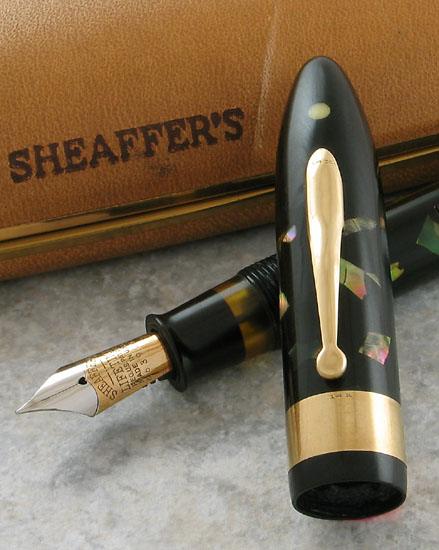
Sheaffer Balance Autograph In Ebonized Pearl c1934-1935
An interesting element of the Autograph advertising is that it promised security against loss. The pen would carry the owner's signature, "exactly as you write it," on the band. Sheaffer also promoted this as a form of "signature identification." The wider cap band is a visual cue for Sheaffer Autograph pens of this period.
By 1936, color disappears from the Autograph palette, and the pen becomes the black only De Luxe Autograph line, "the aristocrats of writing instruments," and positioned as the top of the line in the catalog. The Visulated lever-fill pen came in four sizes, from the largest Balance to the small "First Lady" size, all selling for US $18.00. The Vacuum-Filler pen came in three sizes for the same price. Matching pencils were US $12.00.
In the 1937 catalog, Sheaffer expanded the line and restructured the pricing, with two men's pen sizes selling for US $20.00 and the ladies size for US $18.00. Both were available with either vacuum or lever fillers. The matching pencils were US $15.00 for men's and US $12.00 for ladies. A new, lower priced De Luxe Autograph was introduced, with only the 14 karat gold wide cap band, with the clips and pencil cones gold filled. The pen was the smaller man's size and was US $16.50, with either filler and the matching pencil was US $8.50.
In 1938, the lineup, fillers, and pricing remains the same, but Sheaffer, for its 25th anniversary, introduces model names across its pen lines. The largest Deluxe (no space) Autograph Lifetime pen is named the Heritage, equal in size to the new Premier. The new Excellence Autograph Lifetime is the same size as the new Statesman, the second men's model. The ladies' pen is simply the Lady Autograph, and the 14 karat cap band / gold filled clip and cone model became the Viceroy Autograph Lifetime, and differs only in trim from the Excellence. These names, features, and prices carry through the introduction of the Triumph pen line in 1942.
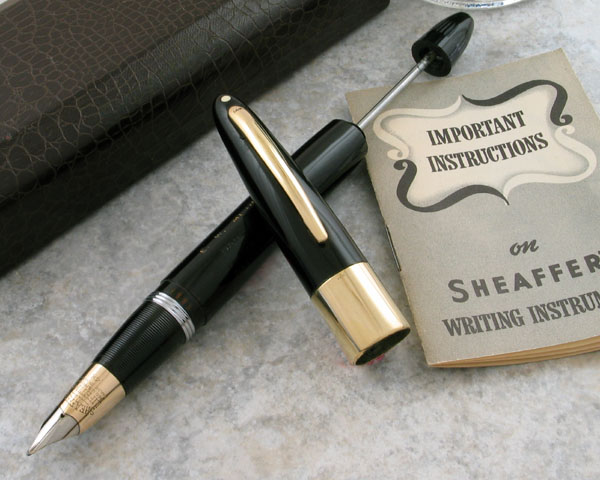
Sheaffer Triumph Vacuum-Fill Autograph Pen c1946-1948
From 1942-1945 both the all gold-filled trim and Autograph Triumph pens had wide cap bands. The Autograph pens can be distinguished by their plain cap bands and the 14K hallmark at the top of the band under the clip. From 1942-1944, gold-filled cap bands were decorated with a repeating parallel line engraving, a vertical chasing. By 1945, the Triumph line was redesigned, and the Valiant model continued the wide cap band, but with a pair of engraved bands around the top and bottom. Sheaffer narrowed the cap band on the Valiant in 1946, leaving the Autograph as the sole wide-band model. Triumph Autograph pens were made as standard and Tuckaway models.
When the Touchdown was introduced in 1949, Sheaffer continued the Autograph in standard and Tuckaway versions, and in black only. Both Autographs were offered in pen for US $20.00, pencil for US $15.00, and Stratowriter ballpoint for US $15.00.
The TM (Thin Model) and Snorkel Autograph and Signature Pens
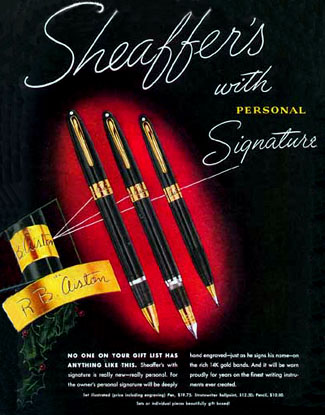
Sheaffer TM
Signature Pen Advertisement 1950
The wide band Autograph was continued when the Touchdown line was slimmed down in 1950 to the new TM or Thin Model Touchdown pen line. The Tuckaway was dropped, but a new 14 karat gold cap band model was introduced: the Signature. The new Signature is a nod back to the Viceroy Autograph Balance pens of 1938-1941, with a narrow 3/8 inch 14 karat gold cap band, the same width band as the Valiant TM, and gold filled clip and pencil cone. Unlike the Viceroy, the Signature does not include Autograph in its name. While the Autograph continued only in black, the Signature was made in three colors: black, burgundy, and evergreen green. The Autograph TM pen sold for US $20.00, and matching pencils and capped Stratowriter ballpoints were US $15.00. The Signature sold for US $19.75, and matching pencils were US $10.00 and slip cap ballpoints were US $12.50.
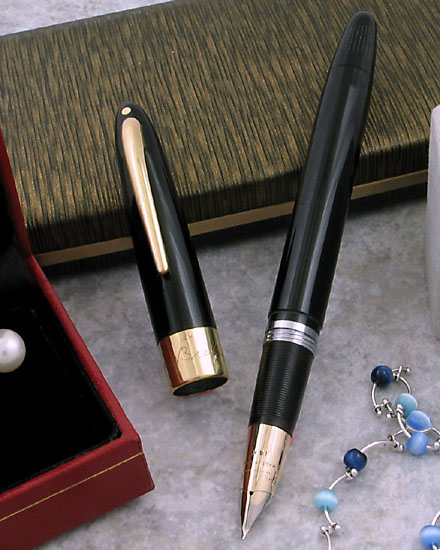
Sheaffer TM Signature Pen 1950-1952
In 1952, Sheaffer introduced the new Snorkel and continued the Autograph and Signature models in the new line. The pens kept the same colors and features as in the TM line, though the green Signature was in pastel green. Both pens were fitted with the Triumph 14 karat two-tone gold nib with platinum mask. The Signature Snorkel pen sold for US $25.00, the matching pencil was US $10.00, and a slip cap ballpoint (1952-1955) was US $10.00. A pushbutton Signature ballpoint was introduced later in production and sold for US $10.00. The Autograph Snorkel pen sold for US $27.50, the matching pencil was US $17.50, and a slip cap ballpoint (1952-1955) was US $17.50.
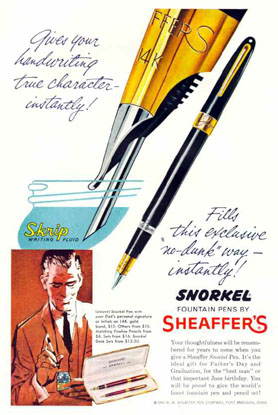
Sheaffer
Snorkel Signature Advertisement 1959
The Autograph TM and Snorkel are easily spotted by the unique and much wider cap band. The Signature models are a bit more easily confused with the Valiant and Statesman models, both from having bands the same size, and from mismatches of palladium-silver nibs on some Signature pens. In addition to the 14 karat hallmark on the band, the Signature has a plain band, while the Valiant and Statesman have an engraved line at the top and bottom of the cap band.

Sheaffer Snorkel Signature Green (Left) / Statesman
Blue (Right) c1952-1959
May We Have Your Autograph, Please?
Sheaffer included with each Autograph pen a booklet titled, "May we have your Autograph, please?" This booklet tells the new owner to sign his or her name three times on a card that will be returned with the pen to Sheaffer. There are three check boxes on the card so the owner can select the best signature. The pen should then be shipped insured to Sheaffer, who engraves it at no charge and returns it prepaid.
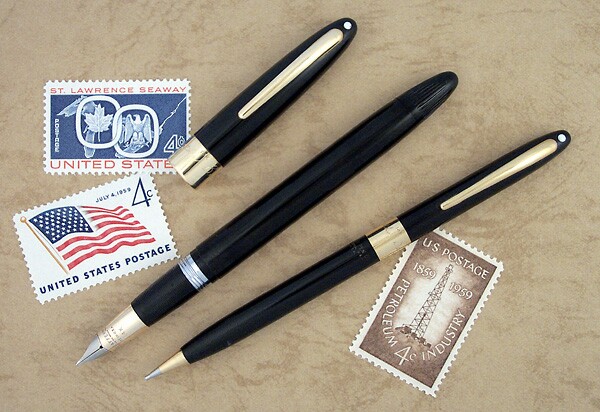
Sheaffer Snorkel Signature Pen and Pencil Set c1952-1959
So How Did Sheaffer Get The Signatures On The Pens?
This question is actually the inspiration for the article! When I got my first Sheaffer Snorkel Autograph pen, I admired the wonderful engraving on the cap band, "Alex McNab." I wondered who he might be and how his signature was copied onto the pen. I stumbled across a few Sheaffer advertisements from the 1950s and saw a few that clearly stated that the Autograph and Signature models were offered with "the owner's own signature" engraved on the band. The procedure was to buy the pen at your local dealer, sign a signature card, and send the pen and the card to Sheaffer for engraving. Several weeks later, your pen would come back with your signature on it! Amazing!
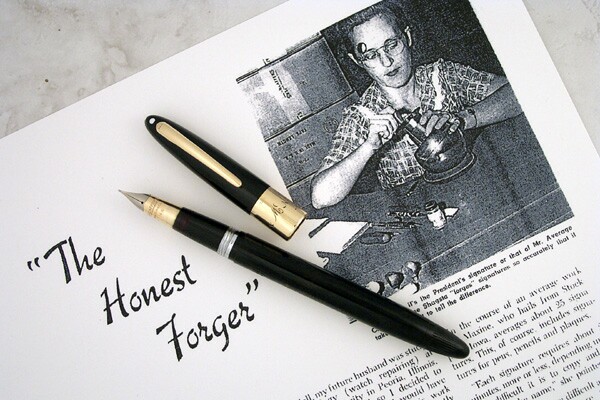
Sheaffer Snorkel Autograph c1952-1959
Sam Fiorella, Rob Astyk and I corresponded on this several times trying to track down the answer. An obvious solution would be that Sheaffer employed a pantograph, a complex device used by engravers, drafters and artists to make exact copies of original works. In fact, the answer is much simpler: forgery.
Sheaffer employed "honest forgers," jewelry engravers highly skilled in copying the handwritten signatures from the cards sent in by pen owners onto the bands on the pens. Signatures of presidents, senators, the famous, and the honored all had their signatures hand copied onto the bands of Autograph and Signature pens and the plaques of desk sets, according to the article "The Honest Forger," in the October, 1953 Sheaffer's Review. Practiced hands made copies hard to distinguish from the original, not only on the flat surface of a plaque, but around the band of a pen.
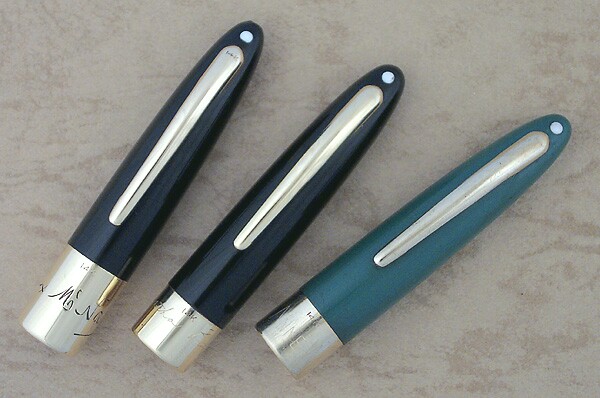
Detail of Snorkel Autograph and Signature Pen Caps
Note 14K Markings And Engravings
In the article, Maxine Shagsta, describes how she came to be at Sheaffer and the work involved. "Each signature requires about 20 minutes, more or less, depending upon how difficult it is to copy and the length of the name." Alex McNab probably took less time than Judith Ann Williams, unless one of them had really sloppy handwriting. "Some of the more difficult and time consuming signatures are those of foreign princes and dignitaries that we receive from time to time. They seem to have more curlicues and flourishes." An average day would produce about 25 signatures copied onto pens, pencils and plaques.
Because the work is being done on 14 karat gold, great care would be taken to avoid mistakes. The work is done directly on the pen, held securely in a special vise mounted on a large ball-shaped engraver's block. The first step is to coat the band with "a chalk-like powder into which the individual's signature is carefully sketched. Then, using a graver, which is a sharp engraving knife," the engraver cuts a perfect copy of the signature into the band, rotating it around until the work is done.
A very different story than expected, but more personal, for that personal signature, for sure.
Performance
This review is of the Alex McNab Autograph pen shown here and in the March 2002 PenInHand. Except for the 14 karat appointments, this is a typical Sheaffer Valiant Snorkel in black. It's about 5 5/8 inches long capped and 6 3/8 inches posted, and though a long pen in the hand, is a touch on the lighter side, being a mostly plastic pen.
Snorkels are well balanced, whether the cap is posted or not, and are generally excellent writers. The longer barrel makes the pen more comfortable unposted than the shorter TM Touchdown pens, which seem better posted. The caps and section both have metal threads, giving the cap a secure, positive fit. The 14 karat gold clip is spring loaded, making it easy to clip on, and though it's front mounted, sits deep in a deep pocket, higher in a shallow one, due to its length.
Snorkels may be mechanically complicated, but filling them is a treat. Turning the end cap extends the Snorkel tube, and a quick single downstroke of the Touchdown plunger is all that's needed to fill the pen. Because only the Snorkel tube has to enter the ink, there's no wiping. You're ready to write immediately. These are very reliable pens.
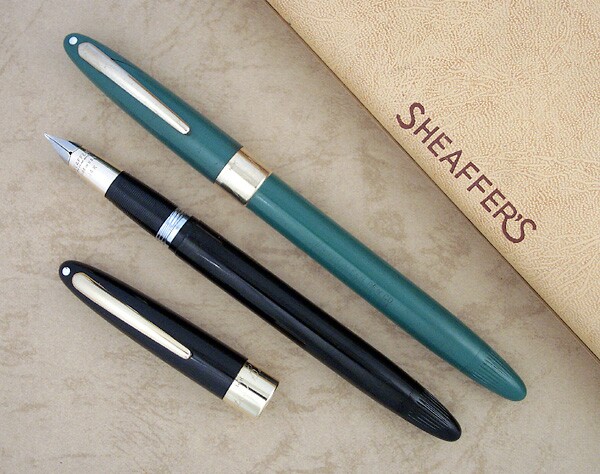
Sheaffer Snorkel Signature Pen In Black And Green
c1952-1959
The Triumph nibs on TM pens are typically stiff, but they are smooth writers, writing fairly wet, but not overly so. Fine and extra fine nibs tend to write on the dry side. This one is particularly smooth.
Pens with engravings surely have an interesting history. I wonder about Alex McNab. Possibly some relative or business gave him this pen as a memento. Surely he was pleased to have it, as am I. A really nice pen, with a twist.
Acknowledgement
Grateful thanks to Sam Fiorella for providing guidance and a copy of the article "The Honest Forger," in the October, 1953 Sheaffer's Review and to Deb Kinney for loaning the Sheaffer Balance Autograph Ebonized Pearl.
Thanks also to Rob Astyk for background information for this article and to Deb Kinney for loaning the Sheaffer Balance Autograph Ebonized Pearl used for photographs.
Comments on this article may be sent to
the author, Jim Mamoulides
PenHero.com Bibliography